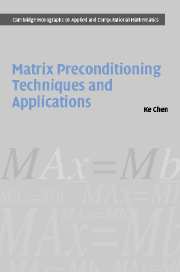Book contents
- Frontmatter
- Contents
- Preface
- Nomenclature
- 1 Introduction
- 2 Direct methods
- 3 Iterative methods
- 4 Matrix splitting preconditioners [T1]: direct approximation of An×n
- 5 Approximate inverse preconditioners [T2]: direct approximation of An×n−1
- 6 Multilevel methods and preconditioners [T3]: coarse grid approximation
- 7 Multilevel recursive Schur complements preconditioners [T4]
- 8 Sparse wavelet preconditioners [T5]: approximation of Ãn×n and Ãn×n−1
- 9 Wavelet Schur preconditioners [T6]
- 10 Implicit wavelet preconditioners [T7]
- 11 Application I: acoustic scattering modelling
- 12 Application II: coupled matrix problems
- 13 Application III: image restoration and inverse problems
- 14 Application IV: voltage stability in electrical power systems
- 15 Parallel computing by examples
- Appendix A a brief guide to linear algebra
- Appendix B the Harwell–Boeing (HB) data format
- Appendix C a brief guide to MATLAB®
- Appendix D list of supplied M-files and programs
- Appendix E list of selected scientific resources on Internet
- References
- Author Index
- Subject Index
- Plate section
5 - Approximate inverse preconditioners [T2]: direct approximation of An×n−1
Published online by Cambridge University Press: 06 January 2010
- Frontmatter
- Contents
- Preface
- Nomenclature
- 1 Introduction
- 2 Direct methods
- 3 Iterative methods
- 4 Matrix splitting preconditioners [T1]: direct approximation of An×n
- 5 Approximate inverse preconditioners [T2]: direct approximation of An×n−1
- 6 Multilevel methods and preconditioners [T3]: coarse grid approximation
- 7 Multilevel recursive Schur complements preconditioners [T4]
- 8 Sparse wavelet preconditioners [T5]: approximation of Ãn×n and Ãn×n−1
- 9 Wavelet Schur preconditioners [T6]
- 10 Implicit wavelet preconditioners [T7]
- 11 Application I: acoustic scattering modelling
- 12 Application II: coupled matrix problems
- 13 Application III: image restoration and inverse problems
- 14 Application IV: voltage stability in electrical power systems
- 15 Parallel computing by examples
- Appendix A a brief guide to linear algebra
- Appendix B the Harwell–Boeing (HB) data format
- Appendix C a brief guide to MATLAB®
- Appendix D list of supplied M-files and programs
- Appendix E list of selected scientific resources on Internet
- References
- Author Index
- Subject Index
- Plate section
Summary
In the last few years we have studied preconditioning techniques based on sparse approximate inverses and have found them to be quite effective.
B. Carpentieri, et al. SIAM Journal on Scientific Computing, Vol. 25 (2003)The objective is to remove the smallest eigenvalues of A which are known to slow down the convergence of GMRES.
Jocelyne Erhel, et al. Journal of Computational and Applied Mathematics, Vol. 69 (1996)The most successful preconditioning methods in terms of reducing the number of iterations, such as the incomplete LU decomposition or symmetric successive relaxation (SSOR), are notoriously difficult to implement in a parallel architecture, especially for unstructured matrices.
Marcus J. Grote and Thomas Huckle. SIAM Journal on Scientific Computing, Vol. 18 (1997)This chapter will discuss the construction of Inverse Type preconditioners (or approximate inverse type) i.e. for equation (1.2)
MAx = Mb
and other types as shown on Page 3. Our first concern will be a theoretical one on characterizing A–1. It turns out that answering this concern reveals most underlying ideas of inverse type preconditioners. We shall present the following.
Section 5.1 How to characterize A–1 in terms of A
Section 5.2 Banded preconditioner
Section 5.3 Polynomial pk(A) preconditioners
Section 5.4 General and adaptive SPAI preconditioners
Section 5.5 AINV type preconditioner
Section 5.6 Multi-stage preconditioners
Section 5.7 The dual tolerance self-preconditioning method
Section 5.8 Mesh near neighbour preconditioners
Section 5.9 Numerical experiments
Section 5.10 Discussion of software and Mfile
- Type
- Chapter
- Information
- Matrix Preconditioning Techniques and Applications , pp. 191 - 239Publisher: Cambridge University PressPrint publication year: 2005

